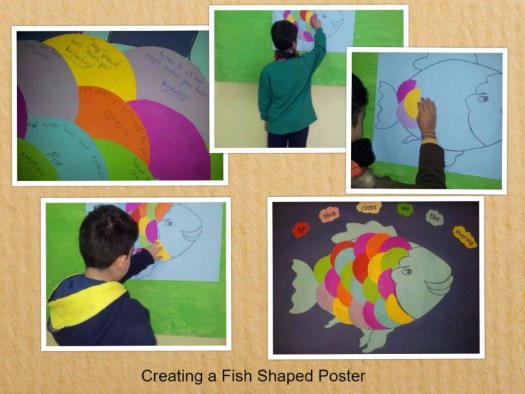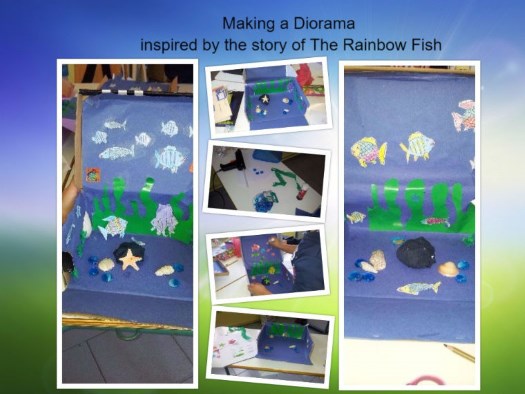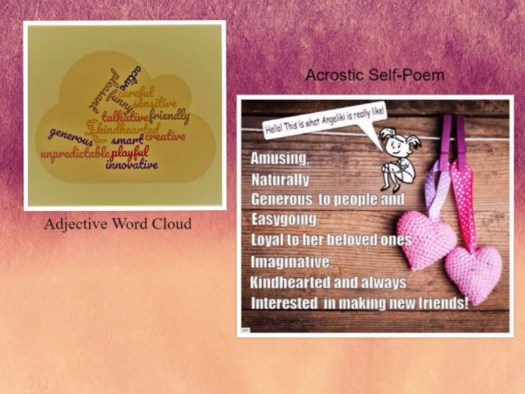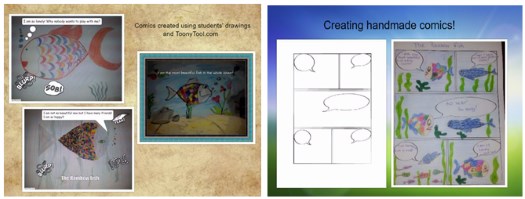Turning a Children’s Story into a Springboard for Creativity and… the Value of Friendship
Angeliki Voreopoulou, Greece
Angeliki Voreopoulou has been an ELT practitioner since 1998. She is currently working in a State Primary school in Northern Greece. She has won a prize for implementing board games in teaching English to very young learners at the Day Conference on Early Language Learning organized by the Greek ministry of Education and the University of Athens. She stimulates her students’ creativity by engaging them in projects fostering critical thinking, collaboration and communication. She shares her practice in seminars, talks and workshops. Her main interests include visual materials, storytelling and the use of Web 2.0 tools into the classroom. E-mail: avoreopoulou@hotmail.com
Menu
Introduction
Getting familiar with the story of The Rainbow Fish
A Fish-shaped Poster
Puppeteering
Making dioramas
It’s interview time
Story treasure hunt
Playing with adjectives
Diary entries
Make a digital e-book
Comics
Conclusion
A few weeks ago I was in a class with really young learners. During one of the activities it happened that one of the pupils didn’t have any coloured markers in her pencil case and although the boy sitting next to her had two sets of them, when she asked if she could borrow some of them, he replied “They’re new and I don’t want to share them with anybody”. Of course this is an incident that might have occurred to you many times during your teaching life; it is very common among young children not being able to share their ‘precious’ possessions. However, we are not only English language teachers giving lessons on grammar and vocabulary; we are there to educate our pupils emotionally as well. Only when students become aware of other people’s feelings, the concept of friendship and sharing, they will be able to interact smoothly with each other thus avoiding intense conflicts and unpleasant confrontations which inevitably affect the lesson’s outcomes.
Bearing these in mind, the story of the ‘Rainbow Fish’ by Marcus Pfister can give us the best framework to start talking about friendship, goodwill and the act of sharing. It also gives us a wealth of opportunities to develop activities that can spark students’ imagination while using creative arts like poetry, story writing, performance and design. Students can explore the true meaning of friendship; develop precious life skills while practicing English language in a meaningful context. The lesson plan that follows is based on the narration of ‘The Rainbow Fish’ found on youtube and it is aimed for teaching students aged between 6 – 11 years old.
Language Level: Elementary (A1) – Intermediate (B1)
Time: 45 minutes
Topic: Feelings and friendship values
Language: Vocabulary related to the sea, colours and feelings
Language Skills: Speaking and listening
Materials: The story of the Rainbow Fish by Marcus Pfister read by Ernest Borgnine on youtube
https://www.youtube.com/watch?v=RbKr-k1PTvA
Activity: Watching the narration of the story, comparing and contrasting images, predicting, discussing
about different feelings, the act of sharing and the values of friendship.
Procedure:
- Tell you students they are going to watch a story entitled the Rainbow Fish. Have they ever seen a
rainbow fish?
- Get feedback and pair learners to brainstorm vocabulary related to fish/ sea (expect answers like:
waves, coral reef, beach etc) – and other aquatic animals they might know (eg octopus, whale, crab,
starfish, seal etc)
- Put students in groups and ask them to draw how they imagine the Rainbow fish.
- Get feedback and show the film. Stop on 0.15: compare and contrast their rainbow fish to the story’s.
How similar or different is it? Ask students to describe it and tell you if they like it.
- Students still in groups brainstorm the key elements of the story. What do they think the story is
about?
- Get feedback and tell them that they are going to watch the rest of the film and see if their predictions
were correct.
- Get feedback and show the film a second time. This time stop it on 0.59 and ask: “Has the Rainbow
Fish got friends? How does he feel?”
- Get feedback and watch the film until 1.57. What does the small blue fish want? Did he get it? What’s
the result of the Rainbow Fish not sharing his scales? Encourage discussion about the importance of
sharing things that we love with the others. Do students share their things?
- Watch the film until 3.10. What advice did the octopus give to the Rainbow Fish? Do you think the
Rainbow Fish will follow this piece of advice?
- Watch the film until 4.30. How does the blue fish feel now? Why? Get feedback and try to focus
students’ attention on different feelings aroused by the heroes of the story up to that moment.
- Watch until the end of the film. How does the Rainbow Fish feel now that he has given away his
glittering scales? Has he got any friends? Why? Discuss.
Follow up activities:
The activities that will follow focus on different aspects of creative arts and they do not have to be used all together. It is up to the creative teacher to decide which one(s) will be of value and interest to his/her students.
Language Level: Elementary (A1) – Intermediate (B1)
Time: 50 minutes
Topic: The act of sharing
Language: Vocabulary related to what we can share with others
Language Skills: Speaking and listening
Materials:
- A big cut out of a fish (to put the scales on)
- Cut out half circles (one for each child) made of construction paper (scales)
- Glitter or any other decorative materials you can get in hand
Procedure:
- Play again the scene when the Rainbow Fish gives away his glittering scales.
- Discuss with students what things they would have liked to share with other people so as to make
them happy. Elicit answers related not only to objects but to benevolent actions like: help around the
house, say please/ thank you, call your grandmother and say you love her etc
- Hand out the scales, one for each student, who write on them what they would like to share with
others.
- Students decorate them as they wish. One after the other read out loud what they have written and add
the scales to the fish.
- At the end you will have a colourful poster with everyone’s ideas on it!
(idea adapted from https://squareheadteachers.com/2014/03/01/rainbow-fish-activities-1/)

Language Level: Elementary (A1) – Intermediate (B1)
Time: 60 minutes
Topic: Feelings and friendship values
Language: Vocabulary related to the sea, colours and feelings
Language Skills: Speaking and listening
Materials:
- The story of the Rainbow Fish
- A transcript of the story with key words/phrases missing so as students to fill them in.
- Construction paper, coloured pens for making the puppets
Procedure:
- Play the story and ask students to complete the missing words/ phrases.
- Get feedback and put students in groups. Allocate roles and ask them to use the transcript of the story
to practice the dialogues.
- Hand out construction paper and create puppets of the main characters of the story.
- Urge students to act out the story using their puppets
A diorama is a way of representing a scene from nature, a historical or fictional event in a very small space using miniature figures and real objects in front of a painted background. They provide immense opportunities for creativity, innovation and collaboration if made by groups of students.
Language Level: Elementary (A1)– Intermediate (B1)
Time: 90 minutes
Topic: Retelling a story, acting out dialogues
Language: Vocabulary related to the sea, colours and feelings
Language Skills: Speaking and listening
Materials:
- A shoe box or any other box that you can get hands on
- Students drawings of the bottom of the sea to create the background of the diorama
- Plasticine to make the waves, rocks, coral reefs etc
- Pebbles and shells for decoration
- A plasticized edition of the heroes of the story drawn by students
- Detailed instructions on how to make a diorama by www.wikihow.com/Make-a-Diorama
Procedure:
- Go over the instructions on how to make a diorama representing the bottom of the sea.
- Get students in groups and give them time to make the dioramas.
- When finished students should re-enact the dialogues of the story and play with the plasticized heroes.
Tip: it would be useful to prepare a diorama in advance so as to provide it as a model.

Language Level: Elementary (A1)– Intermediate (B1)
Time: 40 minutes
Topic: Making and answering interview questions
Language: Vocabulary related to feelings, act of sharing
Language Skills: Speaking and listening
Materials:
- A toy microphone (optional)
- The frame of a TV made of thick cardboard paper
Procedure:
- Ask students to get in pairs and prepare interview questions addressed to the Rainbow Fish, to the
little blue fish and to the wise octopus. The questions should concern the feelings of the heroes at the
various stages of the story, their daily life and/ or their future plans at the bottom of the sea.
- When they have concluded on the questions they want to make, they take up different roles. One
should be the interviewer and the other one of the heroes of the story.
Tip: The students could be standing behind the TV frame holding a microphone, thus making it more realistic as if they are on an actual TV show.
Language Level: Elementary (A1)– Intermediate (B1)
Time: 30 minutes
Topic: Reconstructing and retelling a story
Language: Vocabulary related to the sea, colours and feelings
Language Skills: Speaking and listening
Materials: Two sets of cards representing the key scenes of the story printed on two different colours (students can prepare them in previous lessons or they can be downloaded from http://www.twinkl.co.uk/resources/the-rainbow-fish-story-primary-teaching-resources)
Procedure:
- Divide the class in two teams
- Hide the cards somewhere in the classroom and/or in the school
- Give clues as to where the cards are hidden
- Students should look for them and collect cards of the same colour.
- Whoever finds first all the cards, puts them in order and narrates the story successfully is the winner.
Language Level: Intermediate (B1)
Time: 45 minutes
Topic: Feelings and the qualities of a good friend
Language: Vocabulary related to character traits
Language Skills: Writing and speaking
Materials:
- Several adjectives written on small pieces of paper folded and placed in a pouch. The
adjectives should be related to personality traits both positive and negative. A huge
selection of adjectives and meanings can be found in http://adjectivesstarting.com/
- http://www.tagul.com, http://www.wordle.net/ or any other word cloud generator
Procedure:
- Ask students to brainstorm adjectives related to the personality traits of the heroes of the story and
urge them to justify their choices. For example, ‘the blue fish is playful because he likes playing with
other fish’. Alternatively, students can brainstorm adjectives related to the qualities of a good friend
like: kind, cheerful, playful, caring, respectful etc
- Get students in groups and give them the adjectives in the pouch. Ask them to decide which
adjectives have positive and which have negative meaning. Encourage dictionary/ internet search in
case of unknown vocabulary.
- Get feedback from students and ask them to write acrostic self-poems using their names and as many
of these adjectives as possible.
Alternatively, students can use wordclouds.com, tagul.com or any other word cloud generator to create word clouds in any shape they like (even of a fish) using as many of the adjectives as possible that apply to their personalities and their disposition to friendship.

Language Level: Elementary (A1) – Intermediate (B1)
Time: 30 minutes
Topic: Writing a diary entry
Language: Vocabulary related to feelings, past tenses
Language Skills: Writing
Materials: None
Procedure:
- Ask your students to imagine that they are the Rainbow Fish
- Tell them to keep a diary and write about his days at the bottom of the sea from the day he met the
first fish until the end of the story when the Rainbow Fish decided to share all his scales.
- The narration should be in first person and should include the Rainbow Fish’s point of view as well
as his emotions.
Alternatively, students can imagine being the little blue fish, the wise Octopus or even the star fish and write diaries narrating the same story from different points of view. Students will have the opportunity to develop empathy as they will easily realize that there are always more than one versions of the same story.
Language Level: Intermediate (B1)
Time: 60 minutes
Topic: Story telling
Language: Past tenses
Language Skills: Writing
Materials:
- http://www.ourboox.com/ the word’s simplest free platform for creating e- books.
- Students’ drawings to act as animation of the book
Procedure:
- Get students in groups and ask them to re-write the story using a different hero. For example a Rainbow parrot, a Rainbow Daisy or even a Rainbow – hair doll!
- Encourage students to illustrate their stories by drawing the main heroes.
- Create a digital e-book by using a simple free platform like ourboox.com. Students’ drawings, their voice as well as music and animation can be embedded.
(idea adapted from http://www.teachingideas.co.uk/library/books/the-rainbow-fish)
Language Level: Elementary (A1)– Intermediate (B1)
Time: 50 minutes
Topic: Feelings and friendship values
Language: Vocabulary related to the sea, colours and feelings and the act of sharing
Language Skills : Writing / storytelling
Materials:
- A printed comics template or …
- An online comic strip generator like http://www.toonytool.com/ that allows you to
upload photos, drawings, images and manipulate them as you like.
Procedure:
- Get students in groups.
- Hand out comic book templates (they can be easily found on the internet for free)
- Revise the sequence of the story
- Ask students to draw the captions and write the dialogues between the Rainbow Fish and the other heroes of the story. They can add exclamation marks, thought bubbles, arrows and anything else that can liven up the text.
Alternatively, if there is access to a computer room…
- Get students in groups.
- Ask them to draw the main scenes of the story
- Scan them or take pictures of them and upload them to an online comic generator.
- Students work online and create their own digital comics
No matter which way you prefer (digital or crafty) even the most reluctant students will get engaged in writing and storytelling!

Language learning is far more than memorization of vocabulary and grammar rules. It should involve all five senses with respect to human feelings. Therefore creative arts like poetry, story writing, performance and design have a place in the process of language learning. They do not only offer the means but an authentic context to practice foreign language, express emotions and release creativity. Above all, they offer unique opportunities for memorable lessons with our students!

Please check the Creative Methodology for the Classroom course at Pilgrims website.
Please check the Methodology & Language for Primary course at Pilgrims website.


|